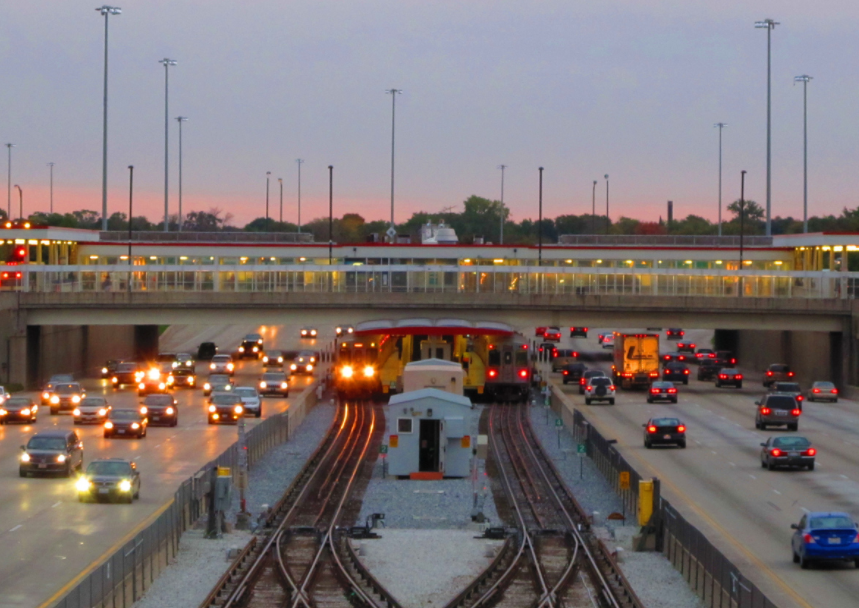Yesterday Donald Trump finally released the blueprint for his much-hyped infrastructure plan. He has promoted the bill for the last year as a $1 trillion program, but it would actually only contain $200 billion in federal funding for infrastructure over the next decade. That money would come from cuts to other programs including grants for transit and Amtrak, which bodes ill for the future of Chicago rail transportation. The current plan calls for $1.5 trillion in infrastructure spending, largely road building, over the next ten years, but most of the money would have to come from local and state governments, as well as private investments.
Trump also released his 2019 budget proposal yesterday. As Streetsblog USA’s Angie Schmitt noted, the budget calls for slashing $3.7 billion from the Federal Transit Administration’s New Starts competitive grant program, a key funding source for mass transit. New Starts has previously funded overhauls of the CTA Brown and Pink Lines, and has been used to add stations and tracks for Metra's North Central, Southwest, and Union Pacific-West lines.
Last month the CTA announced its intention to apply for more than $1 billion in New Starts funding to help pay for the $2.3 billion south Red Line extension project. The grant program would have also been a likely revenue stream for the proposed Ashland bus rapid transit corridor, although that project is currently back-burnered due to community opposition.
A White House official also recently indicated that the Transportation Investment Generating Economic Recovery grant program would be cut. The CTA has previously used TIGER money for the Green Line's Garfield Park Conservatory station and various Blue Line work, and it's currently bankrolling overhauls of the Garfield Green Line stop and the Red Line's 95th Street terminal.
The Chicago Department of Transportation is also using this funding source for its portion of the CREATE program, meant to unsnarl traffic jams on area freight rail corridors. CDOT also won TIGER grants for the elegant, serpentine bicycle-pedestrian bridge that opened in 2016 at 35th Street and the lakefront, as well as the under-construction bike-ped bridge at 41st.
The Trump administration claims that the $200 billion in federal funding (with an estimated $168 billion coming from cuts to federal transit, Amtrak, water, and highway funding) would be used incentivize state and local governments to spend tax dollars on fixing infrastructure like roads, highways, ports, and airports.
As it stands, federal transportation grants generally involve the feds paying 80 percent of a project cost, with local or state governments chipping in 20 percent. Such money has been crucial for local transit improvements, as well as pedestrian and bike initiatives.
But under the new proposal, that ratio would be flipped, so Chicago and/or the state of Illinois would have to come up with 80 percent of the cost. That means that more money would have to be raised locally or via statewide strategies.
Hikes in taxes and tolls would be likely under this scenario, and this pressure might finally persuade state legislators to raise Illinois’ gas tax, which has been stuck at 19 cents a gallon since 1991. A vehicle-miles-traveled tax might be another way to raise money as gas tax revenue drops off due to the increasing popularity of hybrid and electric cars, Metropolitan Planning Council director Audrey Wennink recently told me.
The infrastructure bill, somewhat randomly, would require value capture financing as condition for cities to receive federal funds. This strategy is already in place for the 2.1 billion first phase of the Red and Purple Modernization project, which will rehab stations and track infrastructure between Belmont Avenue and Howard Street. A special tax-increment financing district designated around the project area, which will capture value from property tax revenue increases associated with the improved transit access, is projected to raise $622 million. That allowed Chicago to leverage a $1.1 billion federal grant, awarded shortly before Barack Obama left office a year ago.
But that approach probably wouldn’t work for the south Red Line extension. The Metropolitan Planning Council has estimated that, at best, an RLE transit TIF would raise only $200 million over the next 35 years.
Under Trump’s plan, the White House would also have more direct control over how transportation funds are spent via a new discretionary grant program. That’s bad news for Chicago, because not only has the administration been consistently hostile to funding public transportation, our city frequently served as a whipping boy for Trump during the presidential campaign, so it’s unlikely he’ll do us any funding favors.
In addition, one quarter of the $200 million in federal infrastructure money would be earmarked for rural areas, whose residents form a large part of Trump's political base. However, a full 86 percent of Americans live in metropolitan areas, so cities and suburbs would not receive their fair share of funding.
Not surprisingly, several Illinois and Chicago leaders, such as U.S. Senator Dick Durbin, have blasted the bill. “At his State of the Union address, President Trump promised a $1.5 trillion infrastructure program,” Durbin said in a statement. “Today he released a plan that includes deep cuts to existing infrastructure programs, and shifts the burden of funding onto already cash-strapped cities and states. It will lead to significant increases in tolls and taxes for working Americans.”






